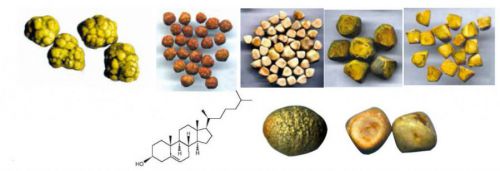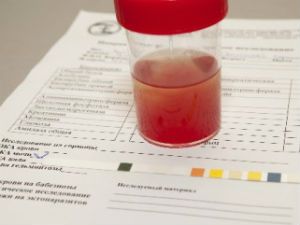The components included in the composition of urinary sediment not only determine its cellular composition, but also they are able to influence the acid-base properties (reaction of urine). From how the acidity levels of urine from a human standard, we can judge about the work of the organs of the urinary tract and the whole organism.
Alkaline reaction of urine, or a change in its pH to the acid side, as a rule, evidence of different metabolic changes, especially if these values are dramatically changed with respect to normal values.
To determine the response of urinary sediment is not an independent method of diagnosis, because without objective and laboratory and instrumental studies of its information content is not so high. However, the situation changes when we are talking about a comprehensive examination of the patient.
Normal levels
The concentration of free hydrogen ions (H+) in the urinary sediment determines what will be the reaction of urine (neutral, acidic, slightly alkaline or alkaline). To simplify the terminology in medicine, the use of the concept of “pH”, implying not that other, as a reaction or acidity of the urine.

Hydrogen ions are formed in the body constantly in the process of a huge variety of biochemical processes. They are excreted by the kidneys in free form and in the form of compounds (for example, in the form of ammonia or phosphates).
The normal reaction of urine of healthy person and children in the older age group does not exceed the range of 5.5 and 7.0 (the average of these indicators is equal to 6,0-6,5)
Reaction of urine 7.0 is considered neutral. This decrease indicates a change in the urine to the acid side, and rising, on the contrary, alkaline shift.
If we are talking about newborn children in the natural (breast) feeding type, that is normal for them is slightly alkaline or neutral pH (7,0-7,8). When the baby is transferred to artificial feeding, the reaction of the urine is reduced to 6,0-7,0 (approaching the values of an adult).
In premature babies, the acidity of the urinary sediment can vary in the range from 4.8 to 5.5. During pregnancy there are more frequent shifts of acidity as a woman’s body is rebuilt on a hormonal and physiological level. Normal pH of urine during the period of gestation is in the range of 5.3 to 6.5.
Changing the reaction of urine and the condition which lead to this
The following describes the changes of pH of urine and their underlying causes.
Sour reaction of urine
If the urine pH is equal to 4.6-5.0 and less, we are talking about the acidic reaction of urine (aciduria).

The reasons for this state can be caused by the following processes:
- the peculiarities of nutrition of the patient (prevalence in the diet of meat and protein-rich food);
- high level of physical activity, intensive sports, living in countries with hot climate, work in the hot shop, etc. (there is a strong dehydration, which increases the acidity of urine);
- pathological state, resulting in metabolic or respiratory acidosis, such as gout, various forms of leukemias, uric acid diathesis, effects of radiation therapy or treatment with cytostatics (the kidneys try to restore the acid-alkaline balance);
- insufficient intake of carbohydrates with food, or prolonged fasting;
- alcohol abuse or intake of surrogates;
- treatment medicines that can change the acidity of the urinary sediment in the direction of its “acidification” (for example, calcium chloride or ascorbic acid);
- diabetes mellitus in decompensation (diabetic ketoacidosis);
- renal failure (acute or chronic);
- a septic condition of the patient;
- kidney disease caused by Escherichia coli or mycobacteria (for example, pyelonephritis or renal tuberculosis).
All alcohol products changes the pH of urine in the acid side
Alkaline reaction of urine
When urine pH exceeds about 7.0, which means that the patient has a urinary pH shifted to the alkaline side (alkaluria).

Elevated pH may indicate the following conditions:
- eating mostly foods of plant origin (in this case, the change in the reaction of the urine is of a reactive nature, i.e. they pass on their own after appropriate adjustments, power);
- persistent alkaline reaction urinary sediment should push the doctor think about infectious processes in organs of the urinary tract, even in the absence of other symptoms (except for diseases caused by Mycobacterium tuberculosis or Escherichia coli);
- a large amount of alkaline mineral water used throughout the day;
- copious vomiting, resulting in loss of fluid and chloride ions;
- diseases of the stomach, accompanied by its high acidity;
- diseases of the urinary system in which urine appears blood (for example, the disintegration of the tumor of the kidney or bladder);
- thyroid disease, adrenal and others.
Quite often alkaluria observed in patients practicing vegetarianism
Pathological conditions, leading to shifts in pH of blood and urine
The table below presents the diseases in which are observed not only shifts the pH of urine in one direction or another, but also corresponding changes in reaction of blood.
| the pH of the urinary sediment | the pH of the blood | The pathological process |
| Of 5.0-6.0 (acidic) | pH<7,35 (acidosis) | Diabetic coma or prekomatosnoe condition, prolonged fasting, severe renal insufficiency, fever, leukemia and others. |
| 8,0-9,0 (alkaline) | pH<7,35 (acidosis) | Chronic bacterial infection organs urinary tract, high concentrations of chloride ions in serum. |
| Of 5.0-6.0 (acidic) | pH>7,35 (alkalosis) | Insufficient content of potassium ions in the blood (hypokalemia), the impact of infusion therapy with large volume of saline (NaCl). |
| 8,0-9,0 (alkaline) | pH>7,35 (alkalosis) | The effects of long term vomiting and diarrhea, intake of alkaline mineral waters or soda, the process of resorption of the exudates or transudate in the body cavity, the inflammatory process in the walls of the bladder (cystitis) and others. |
Long urinary sediment pH change in either direction indicates the beginning of a pathological process
Why is it important to control the pH, and the threatening acid-base shifts in the body?
It is mandatory to determine the response of urine in patients with the following pathological conditions:
- infectious processes in all divisions of the urinary tract (kidney, bladder, or urethra);
- alkalosis or acidosis of different origin (respiratory, renal, metabolic);
- the positive dynamics and efficiency of the therapy.
If the urine for a long period of time, the urine pH declined from normal values in either direction, there is a risk of formation of calculi (stones).

They may have different nature of their origin:
- urate stones are formed from uric acid (the acidity of the urine of such patients is less than 5.0);
- oxalate stones are formed from oxalic acid and its salts (reaction urinary sediment of patients is in the range from 5.0 to 6.0);
- phosphate rocks arise from compounds containing at its core phosphates (acidity of urine while patients exceeds 7,0).
The stones can have very different nature of their origin
If the patient aciduria combined with acidosis, it means that there is a risk for the following complications:
- the change in blood viscosity, increased blood clots, deterioration of the cardiovascular system, decompensation of heart failure;
- violation of all biochemical processes and reactions, increased accumulation in the patient’s body of toxins and other metabolic products;
- the activation of pathogenic and conditionally pathogenic microorganisms, leading to chronic inflammation in the organs of the urinary tract.
Methods of determining the reaction of urine
Currently, there are research methods through which the patient can detect the presence in urine of a number of components and their concentration (leukocytes, erythrocytes, protein, ketone bodies and other parameters).
Reaction of urine (pH), you can easily control at home. It does not require the patient’s specific skills and abilities, as well as deprives him of the need for continued visiting the clinic and the lab, which produced the study.
To determine the pH of urine using the following methodology.
The use of litmus paper, impregnated with active substance (reactant) that can interact with components of urine, resulting in changing its original coloration.
In the study the urine at the same time two drops of litmus paper impregnated with different reagents (blue and red).
To change the color of them is judged on the reaction of urinary sediment:
- if the blue bar is red color, we speak of an acidic pH urine;
- if the red bar has acquired a blue color, we speak of alkaline pH urine;
- if both strips are not changed its color to the opposite, this means that the pH of urine is neutral;
- if both strips change their color to the opposite, then we are talking about amphoteric pH of urine (i.e. the presence of components at the same time, able to oxalacetate and zakislate).

The use of test stripsimpregnated with a special reagent. With their help it is possible not only to detect changes in pH of urine, but also set the numerical values in the analysis.
Test strips can be purchased at any pharmacy, they are allowed to use in patients of any age and gender, while their application is very simple.
After the strip drops into the urine, a biochemical reaction occurs, whereby the indicator portion becomes a color corresponding to the pH of the patient.
In order to determine the pH level enough to compare the result obtained with the color scale shown on the wall of the tube
Rules for collection of urine for accurate determination of its acidity
Not always received the test results reflect the real picture of the processes occurring in the organs of the urinary system, because there are errors in the urine collection or storage.

Therefore, before proceeding to the decoding of the urine, you need to ensure that the patient has complied with all the rules of urine collection and preparation for the procedure, namely:
- Before the study, it is better to limit yourself to a run physical exertion, and to avoid emotional situations. Thus it is necessary to ensure that the day before the urine volume of fluids was sufficient.
- It is not recommended to pass urine women during menstruation, and patients who have observed the seizures repeated vomiting or diarrhea, increased body temperature to febrile values (the results will be false).
- Urine collection required an average portion of urine (first and last portion of urine is drained into the toilet, and the average directly in a sterile container).
- Before you begin gathering the analysis, it is necessary to take care of the toilet of genitals. Women should wash from front to back, and the man carefully treating the penis.
- Urine was collected into a special sterile container (capacity) that acquire at any pharmacy. This eliminates the pathological propagation of infectious agents are not sterile container.
After the analysis is completed, it must be transported to the nearest laboratory within two hours
Reaction of urine may vary under the influence of different factors, both physiological and pathological origin. Even a one-time increase or decrease its acidity should not be ignored, despite the fact that the overall health of the patient remains satisfactory.
With timely diagnosis changes the pH of the urinary sediment, it is necessary to cure or correct a number of pathological conditions, and to prevent possible complications.



